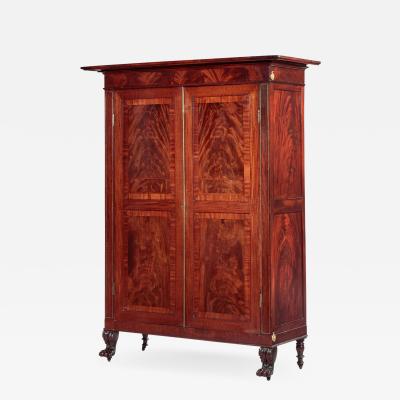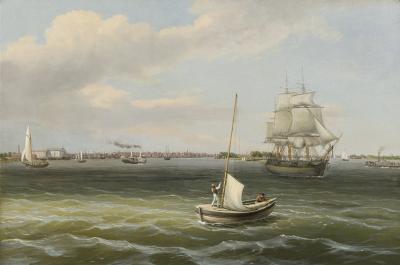During the first decades of the nineteenth century, the highest-level American cabinetmakers and craftsmen produced a stunning array of furniture and decorative arts in Boston, New York, Philadelphia, and Baltimore. Using as their inspiration pieces being imported from England and the Continent, the memory of work seen abroad either before emigrating to the United States or on trips to England and France to study the latest fashions in the decorative arts, and English Regency and French Empire design books available in America shortly after being published abroad, American artisans continued the great tradition of design and craftsmanship that had been firmly established in America during the eighteenth century. Before the exhibition Classical America, 1815–1845 was mounted at the Newark Museum in 1963, little academic attention had been paid to the American neoclassical decorative arts of the early nineteenth century. In 1922, The Metropolitan Museum had organized an exhibition devoted to the “best period” in the career of cabinetmaker Duncan Phyfe (1768–1854), documented in a book by then-curator Charles Over Cornelius. And in 1939, Nancy McClelland authored another book on Phyfe, which for a long time served as the definitive text on the subject. Otherwise, there was almost nothing published before the mid-twentieth century in the overall literature on American Neoclassical furniture, silver, metalwork, lighting, porcelain, and glass. But little by little, the glories of the period have been unfolding, through Classical Taste in America, 1800–1840 (1993) at the Baltimore Museum of Art, as well as more specialized monographic studies on cabinetmakers Charles-Honoré Lannuier (1998) and Duncan Phyfe (2011) at The Metropolitan Museum of Art, Thomas Seymour at the Peabody Essex Museum in Salem, Massachusetts (2003), and most recently, Isaac Vose at the Massachusetts Historical Society, Boston (2018). In the silver field, the thematic exhibition and book, Marks of Achievement, Four Centuries of American Presentation Silver, arrived in 1987, and in 2007, Winterthur organized a comprehensive Fletcher & Gardiner exhibition. Other exhibitions and museum acquisitions and publications have gradually added to the breadth and depth of our knowledge of this period.
Hirschl & Adler Galleries, New York, has been active in the field since the 1980s, and since 1991 has arranged seven exhibitions devoted to various aspects of neoclassicism in America. Augmenting the Canon, at Hirschl & Adler Galleries, the eighth exhibition in this series, brings to public view approximately sixty works — including furniture, silver, glass, ceramics, lighting, and needlework, all recent acquisitions, and most previously unpublished — that further enrich the body of material from this seminal moment in American history.
.jpg) |
Box sofa attributed to Duncan Phyfe (1770–1854), (active 1794–1847), New York, about 1818–1820. Rosewood, and mahogany (feet), partially paint-grained rosewood and gilded (secondary woods: ash and black cherry), with ormolu mounts, die-stamped brass inlay inset with rosewood, brass line inlay, gilt-brass sabots and castors, and upholstery. H. 33¼, L. 82, D. 27¼ in. |
One of the handsomest forms of furniture produced in the United States during the 1820s, and perhaps into the 1830s, was the so-called “box sofa,” named either for its box-like form or for the fact that its seat is often upholstered over a separate frame made like a large slip seat. The prototype for these sofas may be a group of three designs for a “library sofa” reproduced by George Smith as plate 60 in his A Collection of Designs for Household Furniture and Interior Decoration in the Most Approved and Elegant Taste (1808). The accompanying text notes that the “Three Designs for Sofas [are] intended for Libraries,” and suggests that “the frames…should be of mahogany.” Not surprisingly, all of the examples that have appeared have been made of mahogany—save for this example and an identical sofa in the collection of the Art Institute of Chicago — both of which are executed in rosewood and may have been an original pair. All sofas in the group appear to be of New York origin, and the French ormolu mounts that ornament the front seat rail of the two rosewood sofas are of patterns that appear frequently on pieces associated with the shop of Duncan Phyfe.
 |
-003.jpg) |
Monumental pier table with brass inlay attributed to Joseph Barry (1757–1838), Philadelphia (active 1794–1833), about 1815. Mahogany and rosewood (secondary woods: pine and poplar), with gilt-brass mounts, die-stamped brass inlay, some inset with ebony, mirror plate, and marble. H. 39⅛, W. 44¼, D. 21⅞ in. |
This monumental pier table bears various hallmarks of a Philadelphia style from about 1815. The pair of double columns at each end of the façade duplicates the format of another known Philadelphia pier table, the telescopic turnings that form the lowest register of the four columns are a feature that appears repeatedly in Philadelphia furniture of this period, and, most notably, the wide die-stamped brass inlay along the front and sides of the skirt of the table is seen in a variety of patterns on a group of high-style Philadelphia furniture, including a suite made for the Gratz family, now in the Philadelphia Museum of Art; a sécretaire à abattant with Hirschl & Adler Galleries; and a bookcase on stand in the Linda and George Kaufman Collection at the National Gallery of Art, Washington D.C. Surely this was the type of ornament that Barry was referring to in an advertisement he placed in the Philadelphia General Advertiser for September 1, 1824, “2 Rich Sideboards, Buhl [sic] work,” which has been a catalyst to assign to him various pieces that are adorned in this manner.
 |
-001.jpg) |
“Fancy” side chair attributed to John Finlay (1777–1851) and Hugh Finlay (1781–1831), (active about 1800/01–1830), Baltimore, about 1830. Poplar, painted and gilded (secondary woods: pine and poplar), with die-stamped gilt-brass rosettes, caning, and original red moreen fabric (beneath replacement fabric on rondel). H. 33¾, W. 18⅝, O. D. 23¾ in. |
Although painted furniture of ultimate sophistication was made in virtually all of the major cabinetmaking centers in Federal America, no city produced more or better work in this genre than Baltimore. Much painted furniture produced there has been ascribed to the firm of John and Hugh Finlay, who early in their career received a commission for a set of thirty-six painted chairs, four settees, and two sofas for the Oval Room of the White House, Washington, D.C., all of which were destroyed in the burning of that building in 1814. Among their most dramatic work is a set of chairs, likely numbering at least twenty-four — based upon the incised number of “XXII” on the seat of this chair. Of an unusual design, termed a “wheel back” in Baltimore vernacular, the chair appears to have been based on an ancient Roman folding chair, which had a hinge at the circular area at the back to facilitate the folding of the chair for easy transportation. The survival of original red moreen fabric on the rondel in the center of the backsplat (now reversibly covered with a piece of modern red moreen) served as the inspiration for the red squab that covers the caned seat.
 |
-004.jpg) | -001.jpg) |
Work table attributed to Isaac Vose & Son (active 1819–1825), with Thomas Seymour (1772–1848) as foreman (active in the Vose shop, 1819–25), Boston, about 1819–1824. Rosewood (secondary woods: ash, mahogany, pine, and Spanish cedar), with die-rolled gilt-brass moldings filled with lead, ormolu mounts, steel castors, and fabric work bag. H. 29½, W. 23, D. 17¼ in. |
Bostonian Isaac Vose produced a stunning array of furniture in the neoclassical taste, varying from a delicate interpretation of the style of Londoner George Hepplewhite (1727–1786) to a perfect blend of French Empire and English Regency designs. This work table is exemplary of Isaac Vose & Son’s signature style in the years around 1820, showcasing rich rosewood veneers, French ormolu mounts, and English die-rolled moldings, together with a flawless sense of scale and composition to create an object that stands at the summit of their production. One of four work tables of its general type that have appeared, including one with a trestle base and drop leaves that was included in the 2018 exhibition Rather Elegant Than Showy: The Classical Furniture of Isaac Vose, at the Massachusetts Historical Society, this example offers an unusually elaborate program of ornament with eighteen ormolu mounts and a profusion of beaded brass molding.
 |
-001_0.jpg) |
Banjo clock (the “Improved Timepiece”), Simon Willard (1753–1848), (active early 1780s–1823), Roxbury, Mass., about 1805. Wood, gessoed and partially gilded and painted white, with églomisé glass panels, brass, painted dial, glass, and clock mechanism. H. 42⅞, W. 10⅞, D. 5⅝8 in. Signed and inscribed (in gold, on the lower glass panel): S. WILLARD’S PATENT.
|
| -002.jpg) |
Simon Willard, maker of tall-case (“grandfather”) clocks, thirty-hour Grafton wall clocks, shelf clocks, banjo clocks (“improved timepieces”), and patent alarm (“lighthouse”) clocks, was a member of a large and prominent family of clockmakers. He received a patent in 1802 for his “improved timepiece,” known today as a “banjo clock,” which was to be an upgrade to the thirty-hour wall clock, having to be wound only once a week. A review of the account books of Willard’s Roxbury neighbor John Doggett (1780–1857), who was a noted frame and mirror maker, has confirmed an important working relationship between them. Clearly, Doggett supplied Willard with some — possibly all — of the components of his clocks, likely including the cases themselves. Specifically, between 1804 and 1809, the period during which this clock was made, Doggett billed Willard for more than eighty brackets, or “pedestals,” for his “timepieces,” at prices ranging from $3.25 to $4.00 for pedestals without balls, to $4.50 for those with balls, as seen in this example. Doggett also billed $0.75 for gilding “small” eagles, likely for use as the finials on Willard’s clocks, which were possibly supplied by Salem carver Samuel McIntire (1757–1811).
 |
-002.jpg) |
Two-light Argand chandelier, Johnston Brookes & Co., London (active 1814–35); Retailed by Bemis & Vose, Boston (active 1825–31), London, about 1825. Gilt and patinated bronze, with lamp mechanism, glass shades, blown, frosted, and wheel-cut, and glass chimneys. H. 31⅜, L.17⅞, W. 10½ in. Signed and inscribed, with embossed brass labels (attached to one burner tube): JOHNSTON BROOKES / & C° / MANUFACTURERS / LONDON.; (attached to the second burner tube): BEMIS & VOSE / BOSTON. |
Perhaps the most notable innovation in the field of lighting during the early nineteenth century was made by Franco-Swiss chemist Ami Argand (1759–1803), who devised a way to produce a larger flame that provided twelve times the light of a single candle. The so-called “argand lamp” employed new principles of combustion with the invention of a burner consisting of two concentric tubes surrounding a wick that drew a double current of air to feed the flame and a glass tube used as a chimney that increased the upward flow of air. Very few chandeliers signed by the London firm of Johnston Brookes & Co. have appeared, but those that have are of exceptional quality and have served as the basis for a number of credible attributions to them. The firm’s exact connection to an American clientele has not previously been known, but Robert D. Mussey Jr. and Clark Pearce, in conjunction with their research on the Boston cabinetmaking firms of Vose & Coates and Isaac Vose & Son, discovered documentation of a partnership between Isaac Vose Jr. (1794–1872) and his cousin and brother-in-law Charles Bemis (1789–1874). The firm of Bemis & Vose was in business at 79 Market Street, Boston, from 1825 — the year the cabinetmaking firm of Isaac Vose & Son ceased to operate — and 1831. Little is known of their activity, but they placed an advertisement in the Boston Columbian Centinel on August 10, 1825, announcing that they had “just received from London fifteen cases of Lamps, consisting of Center, Mantle, Side Lamps & c,” which may have included this chandelier, which uniquely bears embossed brass labels with the names of Johnston Brookes and Bemis & Vose.
 |
-001.jpg) |
Covered ewer, Simon Chaudron (1758–1846), Philadelphia, about 1807–1809. Silver. H. 16½ in. Weight: 60.3 troy oz. Signed and inscribed (with touch, in ribbon, under base): CHAUDRON; (with engraving, within wreath, under spout): AMC; (below wreath): A GIFT OF GRATITUDE. Weight: 60.3 oz. Troy.
|
Jean Simon Chaudron, born in France and trained in watchmaking and silversmithing in Switzerland, arrived in Philadelphia in 1793 after nearly ten years in the French colony of Saint Domingue (now Haiti). While he initially opened a shop that dealt in jewelry, watches, and imported silver, he gradually added silver of his own manufacture to his inventory. With a clear understanding of French neoclassical design, and access to contemporary design books from Europe and England, his work reflected the style and motifs of the early Napoleonic period. For example, the design for this very sophisticated and complex covered ewer pays homage to Thomas Hope, whose publication Household Furniture and Interior Decoration (1807) included images of ewers with related handles, masks, serpents, and other details.
 |
-001.jpg) | -002_0.jpg) |
The Andrew Craig Walker handled urn, Tucker Factories, (active 1826–1838), Philadelphia, 1828. Porcelain, partially painted in polychrome and gilded, with an iron tie-rod for assembly. H. 1011⁄16 in. Inscribed and dated (on the back): ACW. /1828.
|
In an attempt to bring the manufacture of hard-paste porcelain to the United States, in 1826, William Ellis Tucker organized a business to make porcelain in Philadelphia to emulate the production of the French porcelain manufactories. Many of the wares produced by the Tucker Factories were utilitarian, but they also made a number of pieces that were purely decorative. Among these is a vase with caryatid handles, decorated on one side with a floral bouquet, and, on the back, the initials “ACW” for Andrew Craig Walker, who was an important modeler at Tucker. The vase is also dated 1828, just two years into the Tucker enterprise, suggesting that even their early work was quite sophisticated. And, while it is rarely difficult to distinguish a piece of Tucker porcelain from its French prototypes, the goal was, nevertheless, to be as close as possible to what we today call “Old Paris” porcelain, which was being regularly — and bountifully — imported for wealthy Americans at the time.
 |
.jpg) |
Deep amethyst “lacy” compote in the “Princess Feather” pattern, Boston & Sandwich Glass Company (active 1825–88), Sandwich, Mass., about 1835–1845. Glass, pressed. H. 6¼, L. 10⅝, W. 8¾ in.
|
After the formative years of the Boston & Sandwich Glass Company had successfully passed, a new style of glass was developed with a stippled, or “lacy,” background that would help to conceal various foreign particles in the glass. Most of these pieces were produced in clear, or colorless, glass, but occasionally colored pieces were made. Of these, the largest and most imposing was a compote in the “Princess Feather” pattern, which was offered in sapphire blue, canary yellow, turquoise blue, wisteria, and the deep amethyst of this example.
Augmenting the Canon, Recent Acquisitions of American Neo-Classical Decorative Arts will be on view at Hirschl & Adler Galleries (www.hirschlandadler.com ) in the Fuller Building at 41 East 57th Street, 9th Floor, New York, New York 10022, through February 15, 2019. A fully-illustrated 104-page book, written by father-daughter team Elizabeth Feld and Stuart P. Feld, is available at the gallery and through Amazon.
Elizabeth Feld is managing director of Hirschl & Adler Galleries and director of its furniture and decorative arts department. Stuart P. Feld celebrates his fiftieth anniversary at the helm of Hirschl & Adler Galleries with this exhibition.
All photography by Eric Baumgartner.
This article was originally published in the 2019 Anniversary/Spring issue of Antiques & Fine Art magazine, a fully digitized version of which is available at www.afamag.com

.jpg)

-003.jpg)


-004.jpg)
-001.jpg)

-001_0.jpg)
-002.jpg)

-002.jpg)

-001.jpg)

-001.jpg)
-002_0.jpg)

.jpg)


















-001.jpg)
















